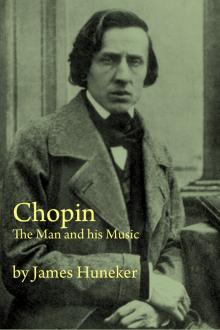Chopin: The Man and His Music, James Huneker [free e books to read online txt] 📗

- Author: James Huneker
- Performer: -
Book online «Chopin: The Man and His Music, James Huneker [free e books to read online txt] 📗». Author James Huneker
Hugo Riemann and Hans von Bulow, may have outstripped him, but as a whole his editing is amazing for its exactitude, scholarship, fertility in novel fingerings and sympathetic insight in phrasing. This edition appeared at Moscow from 1873 to 1876.
The twenty-seven studies of Chopin have been separately edited by Riemann and Von Bulow.
Let us narrow our investigations and critical comparisons to Klindworth, Von Bulow, Kullak and Riemann. Carl Reinecke’s edition of the studies in Breitkopf & Hartel’s collection offers nothing new, neither do Mertke, Scholtz and Mikuli. The latter one should keep at hand because of the possible freedom from impurities in his text, but of phrasing or fingering he contributes little. It must be remembered that with the studies, while they completely exhibit the entire range of Chopin’s genius, the play’s the thing after all. The poetry, the passion of the Ballades and Scherzi wind throughout these technical problems like a flaming skein. With the modern avidity for exterior as well as interior analysis, Mikuli, Reinecke, Mertke and Scholtz evidence little sympathy. It is then from the masterly editing of Kullak, Von Bulow, Riemann and Klindworth that I shall draw copiously.
They have, in their various ways, given us a clue to their musical individuality, as well as their precise scholarship. Klindworth is the most genially intellectual, Von Bulow the most pedagogic, and Kullak is poetic, while Riemann is scholarly; the latter gives more attention to phrasing than to fingering. The Chopin studies are poems fit for Parnassus, yet they also serve a very useful purpose in pedagogy. Both aspects, the material and the spiritual, should be studied, and with four such guides the student need not go astray.
In the first study of the first book, op. 10, dedicated to Liszt, Chopin at a leap reached new land. Extended chords had been sparingly used by Hummel and Clementi, but to take a dispersed harmony and transform it into an epical study, to raise the chord of the tenth to heroic stature—that could have been accomplished by Chopin only. And this first study in C is heroic. Theodore Kullak writes of it: “Above a ground bass proudly and boldly striding along, flow mighty waves of sound. The etude—whose technical end is the rapid execution of widely extended chord figurations exceeding the span of an octave—is to be played on the basis of forte throughout. With sharply dissonant harmonies the forte is to be increased to fortissimo, diminishing again with consonant ones. Pithy accents! Their effect is enhanced when combined with an elastic recoil of the hand.”
The irregular, black, ascending and descending staircases of notes strike the neophyte with terror. Like Piranesi’s marvellous aerial architectural dreams, these dizzy acclivities and descents of Chopin exercise a charm, hypnotic, if you will, for eye as well as ear. Here is the new technique in all its nakedness, new in the sense of figure, design, pattern, web, new in a harmonic way. The old order was horrified at the modulatory harshness, the young sprigs of the new, fascinated and a little frightened. A man who could explode a mine that assailed the stars must be reckoned with. The nub of modern piano music is in the study, the most formally reckless Chopin ever penned. Kullak gives Chopin’s favorite metronome sign, 176 to the quarter, but this editor rightly believes that “the majestic grandeur is impaired,” and suggests 152 instead. The gain is at once apparent. Indeed Kullak, a man of moderate pulse, is quite right in his strictures on the Chopin tempi, tempi that sprang from the expressively light mechanism of the prevailing pianos of Chopin’s day. Von Bulow declares that “the requisite suppleness of the hand in gradual extension and rapid contraction will be most quickly attained if the player does not disdain first of all to impress on the individual fingers the chord which is the foundation of each arpeggio;” a sound pedagogic point. He also inveighs against the disposition to play the octave basses arpeggio. In fact, those basses are the argument of the play; they must be granitic, ponderable and powerful. The same authority calls attention to a misprint C, which he makes B flat, the last note treble in the twenty-ninth bar. Von Bulow gives the Chopin metronomic marking.
It remained for Riemann to make some radical changes. This learned and worthy doctor astonished the musical world a few years by his new marks of phrasing in the Beethoven symphonies. They topsy-turvied the old bowing. With Chopin, new dynamic and agogic accents are rather dangerous, at least to the peace of mind of worshippers of the Chopin fetish. Riemann breaks two bars into one. It is a finished period for him, and by detaching several of the sixteenths in the first group, the first and fourth, he makes the accent clearer,—at least to the eye. He indicates alla breve with 88 to the half. In later studies examples will be given of this phrasing, a phrasing that becomes a mannerism with the editor. He offers no startling finger changes. The value of his criticism throughout the volume seems to be in the phrasing, and this by no means conforms to accepted notions of how Chopin should be interpreted. I intend quoting more freely from Riemann than from the others, but not for the reason that I consider him as a cloud by day and a pillar of fire by night in the desirable land of the Chopin fitudes, rather because his piercing analysis lays bare the very roots of these shining examples of piano literature. Klindworth contents himself with a straightforward version of the C major study, his fingering being the clearest and most admirable. The Mikuli edition makes one addition: it is a line which binds the last note of the first group to the first of the second. The device is useful, and occurs only on the upward flights of the arpeggio.
This study suggests that its composer wished to begin the exposition of his wonderful technical system with a skeletonized statement. It is the tree stripped of its bark, the flower of its leaves, yet, austere as is the result, there is compensating power, dignity and unswerving logic.
This study is the key with which Chopin unlocked—not his heart, but the kingdom of technique. It should be played, for variety, unisono, with both hands, omitting, of course, the octave bass.
Von Bulow writes cannily enough, that the second study in A minor being chromatically related to Moscheles’ etude, op. 70, No. 3, that piece should prepare the way for Chopin’s more musical composition. In different degrees of tempo, strength and rhythmic accent it should be practised, omitting the thumb and first finger. Mikuli’s metronome is 144 to the quarter, Von Bulow’s, 114; Klindworth’s, the same as Mikuli, and Riemann is 72 to the half, with an alla breve. The fingering in three of these authorities is almost identical. Riemann has ideas of his own, both in the phrasing and figuration. Look at these first two bars:
[Musical score excerpt without caption: ]
Von Bulow orders “the middle harmonies to be played throughout distinctly, and yet transiently”—in German, “fluchtig.” In fact, the entire composition, with its murmuring, meandering, chromatic character, is a forerunner to the whispering, weaving, moonlit effects in some of his later studies. The technical purpose is clear, but not obtrusive. It is intended for the fourth and fifth finger of the right hand, but given in unison with both hands it becomes a veritable but laudable torture for the thumb of the left. With the repeat of the first at bar 36 Von Bulow gives a variation in fingering. Kullak’s method of fingering is this: “Everywhere that two white keys occur in succession the fifth finger is to be used for C and F in the right hand, and for F and E in the left.” He has also something to say about holding “the hand sideways, so that the back of the hand and arm form an angle.” This question of hand position, particularly in Chopin, is largely a matter of individual formation. No two hands are alike, no two pianists use the same muscular movements. Play along the easiest line of resistance.
We now have reached a study, the third, in which the more intimately known Chopin reveals himself. This one in E is among the finest flowering of the composer’s choice garden. It is simpler, less morbid, sultry and languorous, therefore saner, than the much bepraised study in C sharp minor, No. 7, op. 25. Niecks writes that this study “may be counted among Chopin’s loveliest compositions.” It combines “classical chasteness of contour with the fragrance of romanticism.” Chopin told his faithful Gutmann that “he had never in his life written another such melody,” and once when hearing it raised his arms aloft and cried out: “Oh, ma patrie!”
I cannot vouch for the sincerity of Chopin’s utterance for as Runciman writes: “They were a very Byronic set, these young men; and they took themselves with ludicrous seriousness.”
Von Bulow calls it a study in expression—which is obvious—and thinks it should be studied in company with No. 6, in E flat minor. This reason is not patent. Emotions should not be hunted in couples and the very object of the collection, variety in mood as well as mechanism, is thus defeated. But Von Bulow was ever an ardent classifier. Perhaps he had his soul compartmentized. He also attempts to regulate the rubato—this is the first of the studies wherein the rubato’s rights must be acknowledged. The bars are even mentioned 32, 33, 36 and 37, where tempo license may be indulged. But here is a case which innate taste and feeling must guide. You can no more teach a real Chopin rubato—not the mawkish imitation,—than you can make a donkey comprehend Kant. The metronome is the same in all editions, 100 to the eighth.
Kullak rightly calls this lovely study “ein wunderschones, poetisches Tonstuck,” more in the nocturne than study style. He gives in the bravura-like cadenza, an alternate for small hands, but small hands should not touch this piece unless they can grapple the double sixths with ease. Klindworth fingers the study with great care. The figuration in three of the editions is the same, Mikuli separating the voices distinctly. Riemann exercises all his ingenuity to make the beginning clear to the eye.
[Musical score excerpt]
What a joy is the next study, No. 4! How well Chopin knew the value of contrast in tonality and sentiment! A veritable classic is this piece, which, despite its dark key color, C sharp minor as a foil to the preceding one in E, bubbles with life and spurts flame. It reminds one of the story of the Polish peasants, who are happiest when they sing in the minor mode. Kullak calls this “a bravura study for velocity and lightness in both hands. Accentuation fiery!” while Von Bulow believes that “the irresistible interest inspired by the spirited content of this truly classical and model piece of music may become a stumbling block in attempting to conquer the technical difficulties.” Hardly. The technics of this composition





Comments (0)